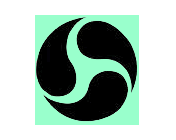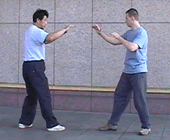

More about Training...
Part of training the mind is in training the will. When you stand for a long time and endure the pain, when you practice a single technique for 1000 times a side every day and learn to enjoy the pain and its benefits, when you do 500 hindu push ups in a single go and begin to learn that some of the borders your mind has set up for you aren't really borders at all -- then you are training the will. This is not only training gongfu, but also a facet of yi.
Laoshi says learn to enjoy the pain.
and...
I actually don't necessarily agree with the formulation of the original question itself. My personal experience and the way that Luo Laoshi taught and explained things to me is that, although most bagua schools do teach these staticly held palms in the beginning of a student's training, our school does not. We consider them more of a refinement of structure, technique, yi, alignments, "feeling", etc. than a beginner's method. We have quite a bit more material that is more important to teach to a beginner up front than these.
Bagua is based on movement and, among other things, learning range of motion. Much of the training that happens up front is to open up a students body to the various types of MOVING drills and forms and two-person practices that are the base of later refinements. For beginning students who have no basis in internal training methods, or bagua in particular, my feeling is that it is better to open them up to beginning forms/drills and the fighting applications that they are connected with. Give them two sides of the coin immediately - fighting and form - and show the connections. Use moving drills over static, not only because this is bagua, but also because that's how fighting works - you don't just stand there.
Gradually you will be introducing more areas of drilling and "play" for fighting, just as you are introducing more variation in form and power training. As students progress, with the direction and explanations of a good teacher, and the diligent physical and mental work of the student, their understanding will become more clear. They will see the connections and the overlap between the various areas of the system. They will understand, intuitively and intellectually, how everything fits together, how the 1 becomes 64 and the 64 become 1.
Everything has a reason, but it is my understanding that using western logic to dissect the system of bagua will only get you so far. I totally understand xxx's feelings about the need and modern necessity of explaining what you're doing, how you should be doing it and why. But here's the rub, some of the stuff in these systems were not always designed with Cartesian logic in mind. Things aren't always so black and white. It isn't a simple linear track of progress from A to B to C to Mastery.
One can say that those static postures are to develop structure, understand relative alignment, refine balance, train yi, reinforce the idea of primacy of footwork/bodywork over arm movements in bagua training, contain certain set pathways for the directions of force, serve as jin-specific power training, set-ups as an external to internal method of leading qi, as holdovers from earlier neigong methods and more. But this is not the sum of their use. Bagua training is not 1+1=2. Bagua (trained well) is 1+1=3.
Second,
Some of this other stuff might be better suited to a separate thread. But the problems with teaching and study of traditional internal martial arts has been a concern to me lately. (As I've whined to some of you.)
Up front - I was probably one of Laoshi's most annoying students in that I always had questions constantly. In fact, I would make it my mission to ask at least one question each time I saw him. I considered it part of the learning process to learn new material in class, to go home and do my homework by not only practicing that material, but then also thinking about its purpose and place within practice, and then to go back to class and ask about any questions that came up during my "homework." Perhaps this was just me, but I didn't consider myself to have done my homework well if I couldn't come up with a question about something... so therefore, more homework would be necessary.
I always did my homework, and I always asked my questions appropriately and with respect. I was never not given an answer. Luo Laoshi is one of the most open and giving teachers I have ever met. And yes I did take advantage of that (to my advantage, and hopefully, eventually to his as well). That is my experience. And I know that others here have felt that as well.
and...
Maybe I'm going to sound like some old geezer complaining about the "youth today," but there's a lot of people who come into a class with both an attitude of entitlement and a palpable sense of laziness.
Laoshi comes from a tradition where its not the teachers job to be a drill instructor or a taskmaster. He had to work hard to get what he got. His teachers (in keeping with tradition) gave him one corner of the puzzle, and he fought, trained, thought, and sought out the other three.
From some of the stories I have heard of him, he has worked harder than nearly everyone I have ever heard to get "the goods." Not only physically, but mentally. Not only to practice what he had, but to research and find what he didn't. He has fought, trained, bled, dedicated his personal life to it, and spent small fortunes to earn and get what he's now got.
If you want to get some of that from him, you have to pay for it how he sees fit. Each person may be different, and again, that's his decision, not yours. Only a small part of what you owe a teacher is in the form of cash, there are many more important ways in which you must earn your tuition. That's always going to be the bottom line.
and...
People in general will always understand things at "their level." If for a few years I know a certain move, and all I ever think of is that its a punch - that's what it is to me. Maybe later someone shows me the same thing as a lock or a throw or something else - now I know more about that one "move" but that one move did not change. My understanding of it did, I understand it at a deeper level, I can use it in more situations.
Bagua is a system of movement and a system of principles. If you read Jess O'Brien's Nei Jia Quan Book (*blatant plug*) interview with Luo Dexiu, he mentions something about putting your material into the "machine" of Bagua and come out with more. This training process is movement and principles, in an abstract sense.
When one is teaching one often has to peg down a move and make it more understandably concrete for a student at their level. But in higher levels of Bagua, these are always a sort of false, or at best a partial, attribution.
